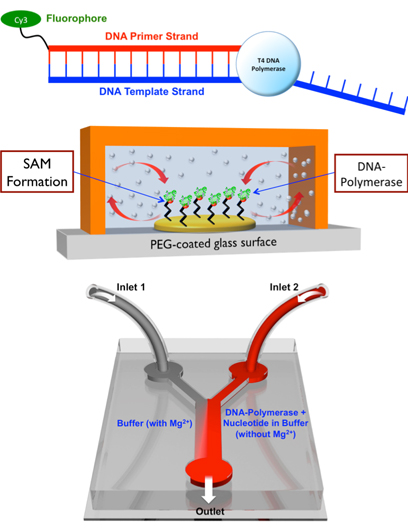
chemotactic behavior, which can be harnessed for directional motion of enzymes and enzyme-attached microparticles.
Leader: Ayusman Sen
DESCRIPTION
IRG2 makes, models, and studies autonomous motors and pumps that convert the free energy of local chemical, optical, thermal, and acoustic fields to motion. In addition to providing information about the mechanisms of motility, the study of synthetic motors helps address fundamental questions about emergent collective behavior at low Reynolds number and on length scales from sub-nanometers to many micrometers. Much of our understanding of active matter derives from continuum theories coupled to observations of complex biological swimmers or externally driven colloidal particles. The observation in abiotic systems of many behaviors previously associated with purely biological processes suggest intriguing questions as to the underlying principles that govern both. The IRG2 team pursues a bottom-up approach to understanding motility, sensing and emergent collective behavior in autonomously driven synthetic systems by combining theory and numerical modeling with the synthesis and experimental study of new classes of motors.
Important findings in IRG2 include the discovery of synthetic autonomous nanomotors and micropumps driven by catalysis and light, elucidation of their self-electrophoretic and diffusiophoretic propulsion mechanisms, discovery of complex swarming, predator-prey, and spatio-temporal oscillatory behavior in colloidal motor assemblies, engineering of chemotaxis, steering, and cargo delivery in motor systems, demonstration of catalytically powered motion at the nm scale of individual catalyst molecules, including (non-motor) enzyme molecules, characterization of momentum transfer by active swimmers at length scales from colloidal to molecular, and discovery of novel acoustic motor propulsion mechanisms that are tolerant of electrolyte solutions and gel media, including the interior of living cells.
RECENT ACCOMPLISHMENTS:
- Showed that catalysts, ranging from molecules to microparticles, undergo directional chemotactic movement in the presence of substrate gradients.
- Observed emergent swarming and predator-prey behavior due to chemotaxis for particles and enzyme molecules that produce self-generated chemical gradients: Achieved control over formation of zones of attraction and exclusion, as well as spatiotemporal reversibility.
- Observed enhanced diffusive motion of individual molecular catalysts and single enzyme molecules in the presence of their specific substrates.
- Demonstrated motors can be powered by ultrasound and exhibit speeds of up to hundreds of microns per second. Emergent collective behavior, including the reversible assembly of multimetallic rods into geometrically regular multimers have been observed.
- Showed that catalytic Janus particles in proximity to a surface undergo constrained in-plane swimming along the wall. The ability to steer Janus motor particles unidirectionally along complicated trajectories by simply following an edge or groove opens the door for many transport and separation tasks.
- Determined that surface-anchored enzymes pump fluid in the presence of their respective substrates.
- Designed self-powered devices for on-demand controlled drug and antidote delivery and for sensing toxic substances in the environment that exploits pumping fluid via enzymes.
- Revealed that trisegmented Au-Ru-Au and Ru-Au-Ru rods trigger electrokinetic fluid pumping along their axis as “pullers” and “pushers”, respectively: Catalytically generated hydrodynamic and electrostatic forces both contribute to pairwise and collective particle assembly.
- Demonstrated that enzymes tethered to microparticles impart directional motility to the particles.
- Observed chemically-driven convective flows leading to transport in and out of dead-end pores that occurs by the phenomenon of “transient diffusioosmosis”. This illustrates that chemical energy in the form of a transient salt gradient can be transduced into mechanical motion, with the pore wall acting as the pump. This phenomena may underlie observed transport in many geological and biological systems involving tight or dead-end micro and nano-channels.

